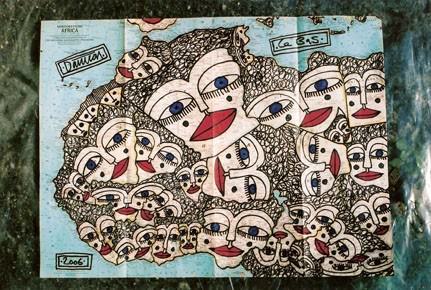Create an account
Welcome! Register for an account
La password verrà inviata via email.
Recupero della password
Recupera la tua password
La password verrà inviata via email.
-
- container colonna1
- Categorie
- #iorestoacasa
- Agenda
- Archeologia
- Architettura
- Arte antica
- Arte contemporanea
- Arte moderna
- Arti performative
- Attualità
- Bandi e concorsi
- Beni culturali
- Cinema
- Contest
- Danza
- Design
- Diritto
- Eventi
- Fiere e manifestazioni
- Film e serie tv
- Formazione
- Fotografia
- Libri ed editoria
- Mercato
- MIC Ministero della Cultura
- Moda
- Musei
- Musica
- Opening
- Personaggi
- Politica e opinioni
- Street Art
- Teatro
- Viaggi
- Categorie
- container colonna2
- container colonna1
52 Biennale – Paradise Lost
Paradiso Perduto è la prima mostra che propone una selezione internazionale di artisti contemporanei Rom. La mostra presenta opere di artisti Rom provenienti da otto paesi europei, i quali accolgono e trasformano, negano e decostruiscono, contestano e analizzano, sfidano e sovrascrivono gli stereotipi esistenti con sicurezza intellettuale, reinventando la tradizione Rom e i suoi elementi di cultura contemporanea
Comunicato stampa
Segnala l'evento
The first Roma Pavilion will open at the 52nd Venice Biennale on June
7, 2007 at 4:30 p.m. to invited guests. The Pavilion, located on the
piano nobile of the 16th-century Palazzo Pisani Santa Marina, Calle
delle Erbe, in the Canareggio district, will feature the premiere of
"Paradise Lost," an exhibition featuring the work of sixteen
contemporary Roma artists representing eight European countries. At
6:00 p.m., following the grand opening festivities, there will be a
panel discussion involving European cultural and political leaders,
including Roma artists and commentators. They will address some of
the fundamental questions and controversy inherent in this first
Biennale Pavilion created along ethnic lines: Is a separate Roma
Pavilion necessary? Is there such a thing as "Roma art"? Does
creating a separate space for Roma artists help or hinder social
inclusion?
World renowned film director Wim Wenders sees the Pavilion as an
opportunity "to correct our image of the largest minority in Europe,
which is still shaped by Gypsy romance and Gypsy kitsch." For
centuries, Roma people have been romanticized by non-Roma artists, who
have conjured up images of barefoot dancers happily banging on
tambourines. At the same time, works created by Roma artists have
been relegated to the level of kitsch by mainstream European arbiters
of culture. The ultimate goal of 'Paradise Lost' is to destroy the
exotic stereotype of the "Gypsies" that has been prevalent in Europe
since the 19th century and to put Roma artists on an equal footing in
the international art world.
According to Tímea Junghaus, curator of the exhibition, "It is our
belief that th e identity of the Roma serves as a model for a modern,
European transnational identity that is capable of cultural fusion and
adaptation to changing circumstances. This is how the invited artists
represent themselves, and this is how they experience their Gypsy
identity."
The Roma Pavilion, alongside the Biennale's national pavilions, marks
the arrival of Roma contemporary culture on the international stage
and sends an important message: Roma have a vital role to play in the
cultural and political landscape of Europe.
7, 2007 at 4:30 p.m. to invited guests. The Pavilion, located on the
piano nobile of the 16th-century Palazzo Pisani Santa Marina, Calle
delle Erbe, in the Canareggio district, will feature the premiere of
"Paradise Lost," an exhibition featuring the work of sixteen
contemporary Roma artists representing eight European countries. At
6:00 p.m., following the grand opening festivities, there will be a
panel discussion involving European cultural and political leaders,
including Roma artists and commentators. They will address some of
the fundamental questions and controversy inherent in this first
Biennale Pavilion created along ethnic lines: Is a separate Roma
Pavilion necessary? Is there such a thing as "Roma art"? Does
creating a separate space for Roma artists help or hinder social
inclusion?
World renowned film director Wim Wenders sees the Pavilion as an
opportunity "to correct our image of the largest minority in Europe,
which is still shaped by Gypsy romance and Gypsy kitsch." For
centuries, Roma people have been romanticized by non-Roma artists, who
have conjured up images of barefoot dancers happily banging on
tambourines. At the same time, works created by Roma artists have
been relegated to the level of kitsch by mainstream European arbiters
of culture. The ultimate goal of 'Paradise Lost' is to destroy the
exotic stereotype of the "Gypsies" that has been prevalent in Europe
since the 19th century and to put Roma artists on an equal footing in
the international art world.
According to Tímea Junghaus, curator of the exhibition, "It is our
belief that th e identity of the Roma serves as a model for a modern,
European transnational identity that is capable of cultural fusion and
adaptation to changing circumstances. This is how the invited artists
represent themselves, and this is how they experience their Gypsy
identity."
The Roma Pavilion, alongside the Biennale's national pavilions, marks
the arrival of Roma contemporary culture on the international stage
and sends an important message: Roma have a vital role to play in the
cultural and political landscape of Europe.
07
giugno 2007
52 Biennale – Paradise Lost
Dal 07 giugno al 21 novembre 2007
arte contemporanea
Location
PALAZZO PISANI
Venezia, Calle de le Erbe (Cannaregio), 6103, (Venezia)
Venezia, Calle de le Erbe (Cannaregio), 6103, (Venezia)
Orario di apertura
10-18, martedì chiuso
Vernissage
7 Giugno 2007, ore 18
Sito web
www.romapavilion.org
Ufficio stampa
ARTE COMMUNICATIONS
Autore
Curatore









